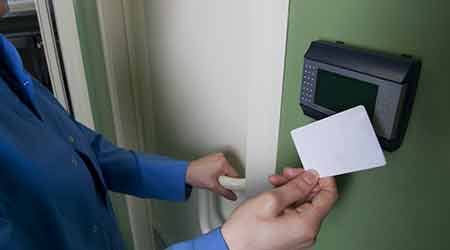Expanded Electric Lock Choices Give Managers Many Options
Part 4 of 4-part article on door hardware
Electronic lock choices are expanding. Among the options are biometric locks, as well as key fob, smart-phone-activated, and even surveillance locks that take a picture and deliver a personalized greeting to each person who enters. The initial, one-time cost of electronic card keys is higher, but the individual key replacement cost is lower because it is just the cost to delete the old card code and recode a new one. The lock remains the same.
Wireless access control choices also have expanded greatly. For example, technicians can install one low-cost model into an existing mechanical cylindrical or mortise device by changing out only the cylinder in about 15 minutes. This cylinder replacement converts a mechanical lock into an electronic ANSI grade 1 with a mechanical override. The change requires no additional wiring or door preparation, and the battery reportedly lasts for 100,000 cycles.
The model is actuated by radio-frequency identification technology and can be unlocked by a key-fob-type transponder from up to 20 inches away. The door only opens when the handle is turned. When the handle is released, it relocks. It can also be fitted with a biometric reader that allows entry only after swiping a finger across the bar to identify and verify authorization for critical applications. System administrators can program the transponder with a laptop- or Blue-tooth-enabled hand held device, and they can program assignable rights to provide certain access times for vendors or maintenance staff.
Unlike mechanical lock cylinders, these keyless locks cannot be picked or tampered with by inserting materials in the key slot. The rolling encrypted code prevents code-breaking. The locks preserve aesthetics because they look just like the mechanical one, so the conversion can be done gradually throughout a facility.
In the final analysis, access control — whether mechanical or electronic — begins with key security. If a key is stolen or lost, given to others, or in some way leaves the possession of the assigned person and falls into the hands of an unauthorized user, a significant breach of security has occurred. At that point, the organization’s security and access control policies and standards help determine the organization’s course of action, and the strength and reliability of the installed door hardware components and access control system comes into play.
Thomas A. Westerkamp is a maintenance and engineering management consultant and president of the work management division of Westerkamp Group LLC.
Related Topics:















